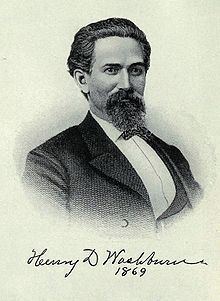Name Henry Washburn | Role U.S. representative | |
 | ||
Born March 28, 1832Windsor, Vermont ( 1832-03-28 ) Rank Brevet Brigadier General Battles/wars American Civil WarBattle of Pea RidgeSiege of VicksburgBattle of Fort EsperanzaBattle of OpequonBattle of Cedar Creek Allegiance United States of America, Union | ||
Place of burial Riverside Cemetery | ||
Henry Dana Washburn (March 28, 1832 – January 26, 1871) was a U.S. Representative from Indiana and a general in the Union Army during the American Civil War.
Biography
Born in Woodstock, Windsor County, Vermont, Washburn attended the common schools. He became a tanner and a currier, and taught school for several years. He moved to Vermillion County, Indiana, in 1850. He graduated from the New York State and National Law School and was admitted to the bar in 1853. He commenced the practice of law in Newport, Indiana. Entering politics, he served as the county auditor from 1854–1861.
With the outbreak of the Civil War, he enlisted in the Union Army on August 16, 1861, serving as lieutenant colonel of the Eighteenth Regiment, Indiana Volunteer Infantry. He distinguished himself at the Battle of Pea Ridge by leading the 18th Indiana in a counterattack to recapture two guns lost from the Peoria battery. He was subsequently promoted to colonel and given command of the regiment on July 15, 1862.
After garrisoning Missouri for the fall and winter, the 18th Indiana was attached to Grant’s army endeavoring to cross the Mississippi and seize Vicksburg. The 18th Indiana fought at Port Gibson and Champion Hill and took part in the siege operations around Vicksburg, where he commanded a brigade commended for valorous actions during the initial assault upon the enemy fortress in May 1863. After the successful end of the Vicksburg operation, Washburn’s brigade remained with the XIII Army Corps involved in operations up the Teche River, and the successful capture of several Rebel forts. In January 1864, the 18th Indiana was sent to Virginia where it participated in several stiff skirmishes. In August 1864, the 18th Indiana was attached to the 4th Brigade, 2nd Division (Grover) of Emory’s XIX Army Corps.
During Sheridan’s campaign to clear the Shenandoah Valley, Washburn commanded the 4th Brigade during heavy fighting at the battles of Opequon, Fisher’s Hill and Cedar Creek. His valor and heroism in the Valley was recognized with a promotion to brevet Brigadier General on 15 December 1864. In the winter of 1864-5, the Nineteenth Corps garrisoned the Savannah area while engaged in raids into Rebel held areas. Soon after mustering out of service, Washburn received promotion to brevet Major General on 26 July 1865 in recognition of his bravery and valor. He mustered out August 26, 1865.
Following the war, Washburn resumed his law practice and returned to politics. He successfully contested as a Republican the election of Daniel W. Voorhees to the Thirty-ninth Congress. He was reelected to the Fortieth Congress and served from February 23, 1866, to March 3, 1869. He was not a candidate for renomination in 1868 to the Forty-first Congress.
He was appointed surveyor general of Montana in 1869 and served until his death. In 1870 he headed the Washburn-Langford-Doane Expedition to explore what would become Yellowstone National Park. Mount Washburn, located within the park, is named for him.
Washburn returned to Clinton, Indiana, where he died on January 26, 1871. He was interred in Riverside Cemetery.
